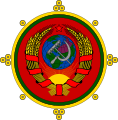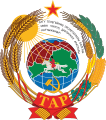| Emblem of the Republic of Tuva | |
|---|---|
 | |
| Armiger | Vladislav Khovalyg, Head of the Republic of Tuva |
| Adopted | 1992 |
The emblem of Tuva is a light blue field with a yellow border. In the center of the field is a traditional horseman, symbolizing Tuva's sovereignty and spirit. The coat of arms was created in 1992, and is similar to the present state emblem of Mongolia, which was adopted that same year.
Meaning of the colors
The yellow symbolizes gold and Tibetan Buddhism. Blue symbolizes the morals of nomadic herdsmen (who are commonly respected in the region), as well the Tuvan sky. The blue pall symbolizes the confluence of the Bii-Khem (Bolshoy Yenisei) and Kaa-Khem (Maly Yenisei) rivers at the Tuvan capital of Qızıl, where they form the Yenisey River, known to locals as the Ulug-Khem River. White symbolizes silver and virtue; additionally, it is common in Tuva for hostesses to greet guests with silver streamers in their arms.
Historical emblems
-
 Emblem of the Tuvan People's Republic (1926–1930)
Emblem of the Tuvan People's Republic (1926–1930)
-
 Emblem of the Tuvan People's Republic (1930)
Emblem of the Tuvan People's Republic (1930)
-
 Emblem of the Tuvan People's Republic (1930–1935)
Emblem of the Tuvan People's Republic (1930–1935)
-
 Emblem of the Tuvan People's Republic (1935–1939)
Emblem of the Tuvan People's Republic (1935–1939)
-
 Emblem of the Tuvan People's Republic (1939–1941)
Emblem of the Tuvan People's Republic (1939–1941)
-
 Emblem of the Tuvan People's Republic (1941–1943)
Emblem of the Tuvan People's Republic (1941–1943)
-
 Emblem of the Tuvan People's Republic (1943–1944)
Emblem of the Tuvan People's Republic (1943–1944)
-
 Emblem of the Tuvan Autonomous Soviet Socialist Republic (1962–1978)
Emblem of the Tuvan Autonomous Soviet Socialist Republic (1962–1978)
-
 Emblem of the Tuvan Autonomous Soviet Socialist Republic (1978–1992)
Emblem of the Tuvan Autonomous Soviet Socialist Republic (1978–1992)
See also
This Russia-related article is a stub. You can help Misplaced Pages by expanding it. |
This heraldry-related article is a stub. You can help Misplaced Pages by expanding it. |